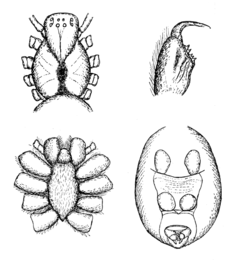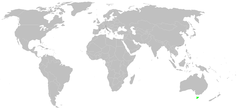Hickmania
| Tasmanian cave spider | |
|---|---|
 | |
| Scientific classification | |
| Kingdom: | Animalia |
| Phylum: | Arthropoda |
| Subphylum: | Chelicerata |
| Class: | Arachnida |
| Order: | Araneae |
| Infraorder: | Araneomorphae |
| Family: | Austrochilidae |
| Genus: | Hickmania Gertsch, 1958[1] |
| Species: | H. troglodytes |
| Binomial name | |
| Hickmania troglodytes (Higgins & Petterd, 1883)[1] | |
 | |
Hickmania is a genus of cribellate spiders with a single species, Hickmania troglodytes, known as the Tasmanian cave spider, that occurs only in Tasmania, where it is widely distributed, especially in underground drainage and cave systems, where large numbers can be found in the entrances.
They are up to 2 cm long, with a legspan of up to 18 cm; its web can have a diameter of more than one meter. The smaller males have a distinct kink-like curve near the end of each second leg. These kinks are used to hold the female's head while mating.
Spiders of these species have an unusually long lifetime for araneomorph spiders: they can last several decades.
This spider, the only one of its own subfamily (Hickmaniinae), is the last of an old Gondwanan lineage; its nearest relatives are found in South America.
It is an icon species for faunal conservation in Tasmania.
Name
The genus name is in honor of an arachnologist called Hickman, a professor from the University of Tasmania who specialised in spiders. The species name is Greek troglodytes, "cave-dweller".
References
- 1 2 "Gen. Hickmania Gertsch, 1958", World Spider Catalog, Natural History Museum Bern, retrieved 2016-02-26
Sources
- Doran, N.E., Richardson, A.M.M. & Swain, R. (2001), "The reproductive behaviour of Hickmania troglodytes, the Tasmanian cave spider (Araneae, Austrochilidae)", Journal of Zoology 253: 405-418